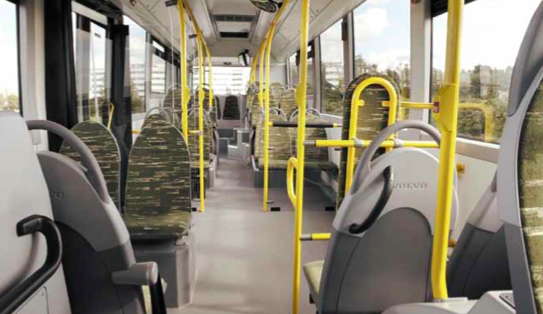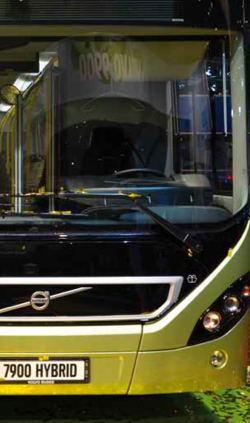The company has sold approximately 300 hybrid buses, both the Volvo 7700 Hybrid and the double-decker Volvo B5L Hybrid.

Volvo Buses is now launching its new low-floor bus, the Volvo 7900. Among many other features, the new bus is lighter, which will generate lower fuel consumption and accommodate more passengers.
The new Volvo 7900 city bus has many similarities with the Volvo 8900, which was launched last year. They share the same body concept, and up to 70 per cent of the components are identical. “This will be highly beneficial to our customers who have both the Volvo 7900 and the Volvo 8900 in their fleets,” says Stefan Guttman, Head of Business Development at Volvo Buses’ Europe Region. “They will be able to use essentially the same routines for maintenance and repairs. Fewer spare parts will be needed in stock, and mechanics will be familiar with both bus models. This will contribute to shorter time in workshops and more time on the roads.”
As with the Volvo 8900, the body of the new model is a mixture of various materials. The company selected the materials that are best suited for various functions. The body structure comprises aluminum profiles that are screwed together and the roof is also made of aluminum.
The aluminum and the patented assembly method will make the bus significantly more resistant to corrosion. There is also an environmental benefit, since aluminum can be recycled by as much as 90 per cent.
 The side panels are manufactured from fiberglass and various plastic materials and are glued together. These light materials produce smooth and attractive sides on the bus, and the side panels are particularly easy to replace if they are damaged. The new design also means that many components are screwed on, making it possible to conduct repairs without the need to weld.
The side panels are manufactured from fiberglass and various plastic materials and are glued together. These light materials produce smooth and attractive sides on the bus, and the side panels are particularly easy to replace if they are damaged. The new design also means that many components are screwed on, making it possible to conduct repairs without the need to weld.
The predecessor, the Volvo 7700, was manufactured in steel, and the company was able to significantly reduce the weight with the new design. For example, the Volvo 7900 hybrid version is a full 550 kg lighter than the current version.
“When the buses become lighter, this generates space for our customers to accommodate more passengers and still fulfill weight requirements,” says Stefan Guttman.
Safety is one of Volvo’s core values and permeates everything the company does. The Volvo 7900 is basically a stable design that complies with the EU’s R66 rollover requirement. The bus has electronically controlled brakes.
All seats can be equipped with two or three-point seatbelts. The engine compartment and the auxiliary heater are fitted with fire detectors and the engine compartment can be fitted with a sprinkler system.
To increase passenger safety, Volvo has developed an integrated surveillance camera that can be installed in all vehicle models. It has also developed an alcohol safety interlock device specifically adapted for bus traffic. The engine can be started without a breathalyzer, but the brakes will remain locked if the breathalyzer reveals that the driver is intoxicated.
The Volvo 7700 was manufactured at the company plant in Wroclaw, Poland. Initially, the Volvo 7900 will also be manufactured there. But since it shares the same body concept as the Volvo 8900, the Volvo 7900 may also be manufactured at the plant in Säffle, Sweden, in the future.
Volvo 8900 new version
Volvo Buses is also launching a new version of the Volvo 8900 low-entry bus. It is a version without podesters and a lower window line in the front of the bus.
Last year, Volvo launched its new regional bus, the Volvo 8900. This is available in a number of versions, with normal floors or as low-entry buses, as 4×2 or 6×2, from 12.2 to 14.7 metres, with seven-litre or nine-litre engines and Volvo’s proprietary I-shift transmission or transmission from ZF or Voith.
“The Volvo 8900 will provide our customers with lower lifecycle costs than in the past,” says Johnny Lidman, Volvo’s Product Manager for city buses in Europe. “The low-entry version of the Volvo 8900 is the best-selling model to date. The concept is an adaptation resulting from numerous demands from operators and passengers for city and regional buses.”
Thanks to the low floor, rapidly entering and exiting the bus is easier through the front and middle doors. It is easy for people with, for example, wheelchairs and baby carriages to travel with the bus.
At the same time, it will be possible for passengers who want to sit higher to do so at the back of the bus. The design also means that the engine will have an optimal location at the back of the bus, which will also make engine servicing easier.
Easy to replace
Thanks to the new design, Volvo Buses was able to reduce the weight of the Volvo 8900, compared with the predecessors. The weight reduction differs between the various versions, but the reduction is about 200-300 kg. The lower weight means that the bus will have room for more passengers, and this will contribute to lower fuel consumption.
Volvo has also designed a new driver’s seat for the revised model. The manner in which drivers perform their duties has an impact on the passenger experience, fuel consumption and the wear and tear of the bus, and thus also on the lifecycle cost of the bus.